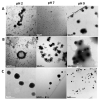Stability of Non-Ionic Surfactant Vesicles Loaded with Rifamycin S
- PMID: 36559121
- PMCID: PMC9785864
- DOI: 10.3390/pharmaceutics14122626
Stability of Non-Ionic Surfactant Vesicles Loaded with Rifamycin S
Abstract
These days, the eradication of bacterial infections is more difficult due to the mechanism of resistance that bacteria have developed towards traditional antibiotics. One of the medical strategies used against bacteria is the therapy with drug delivery systems. Non-ionic vesicles are nanomaterials with good characteristics for encapsulating drugs, due to their bioavailability and biodegradability, which allow the drugs to reach the specific target and reduce their side effects. In this work, the antibiotic Rifamycin S was encapsulated. The rifamycin antibiotics family has been widely used against Mycobacterium tuberculosis, but recent studies have also shown that rifamycin S and rifampicin derivatives have bactericidal activity against Staphylococcus epidermidis and Staphylococcus aureus. In this work, a strain of S. aureus was selected to study the antimicrobial activity through Minimum Inhibitory Concentration (MIC) assay. Three formulations of niosomes were prepared using the thin film hydration method by varying the composition of the aqueous phase, which included MilliQ water, glycerol solution, or PEG400 solution. Niosomes with a rifamycin S concentration of 0.13 μg/g were satisfactorily prepared. Nanovesicles with larger size and higher encapsulation efficiency (EE) were obtained when using glycerol and PEG400 in the aqueous media. Our results showed that niosomes consisting of an aqueous glycerol solution have higher stability and EE across a diversity of temperatures and pHs, and a lower MIC of rifamycin S against S. aureus.
Keywords: antimicrobial activity; drug delivery; niosomes; stability; synthesis and characterization.
Conflict of interest statement
The authors declare no conflict of interest.
Figures








References
-
- Chandu Pola V., Arunachalam A., Jeganath S., Yamini K., Tharangini K., Chaitanya G. Niosomes: A novel drug delivery system liposomes. Int. J. Nov. Trends Pharm. Sci. 2012;2:15.
-
- Ag Seleci D., Seleci M., Walter J.G., Stahl F., Scheper T. Niosomes as nanoparticular drug carriers: Fundamentals and recent applications. J. Nanomater. 2016;2016:7372306. doi: 10.1155/2016/7372306. - DOI
Grants and funding
LinkOut - more resources
Full Text Sources

